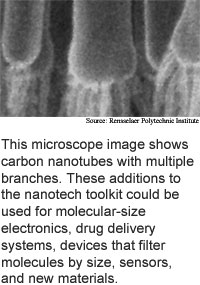
Templates
yield nano branches
Researchers from Rensselaer
Polytechnic Institute have devised a way to make highly branched nanostructures
from many different types of materials.
The researchers' prototypes include a single branch that splits
into as many as 16 branches, and a branch that subdivides as many as four
times. The approach works for a wide range of materials, including metals,
semiconductors, carbon, polymers and insulators, according to the researchers.
The method could eventually be used to make molecular-size electronics,
drug delivery systems, devices that filter molecules by size, sensors,
and relatively complicated nanoscale materials, according to the researchers.
To make the structures the researchers first made a template of
a series of nanopores inside aluminum oxide. To make the templates the
researchers anodized aluminum foil by immersing it in acid and applying
an electrical voltage so that a layer of aluminum oxide containing pores
formed on the foil.
The templates can be used to make structures from any material
that can coat or fill the pores, and allows for precise control of the
dimensions and branching of the nanostructures. The researchers made branched
carbon nanotubes and metallic nanowires.
Researchers had previously made Y-shaped nanostructures using
aluminum oxide templates. The trick to making multiply-branched and hierarchically-branched
structures turned out to be stepping down the voltage used to form the
aluminum oxide.
The researchers' next step is to use the templates to build structures
that combine different materials -- nanotubes, metal nanowires, and polymers.
The method could be used practically in two to ten years, depending
on the application, according to the researchers.
The work appeared in the May 17, 2005 issue of the Proceedings
of the National Academy of Sciences (Controlled fabrication of hierarchically
branched nanopores, nanotubes and nanowires).
Stories:
System carries PC soul
Letter: a short history of TRN
Plug-in protects passwords
Ice transforms chipmaking
Pixels speed quantum crypto
Briefs:
Textures ID paper and plastic
DNA process stamps patterns
Templates yield nano branches
Chemistry moves micro machines

Research Watch blog
View from the High Ground Q&A
How It Works
RSS Feeds:
News
Ad links:
Buy an ad link
Ad links: Clear History
Buy an ad link
|
TRN
Newswire and Headline Feeds for Web sites
|
© Copyright Technology Research News, LLC 2000-2010. All rights reserved.